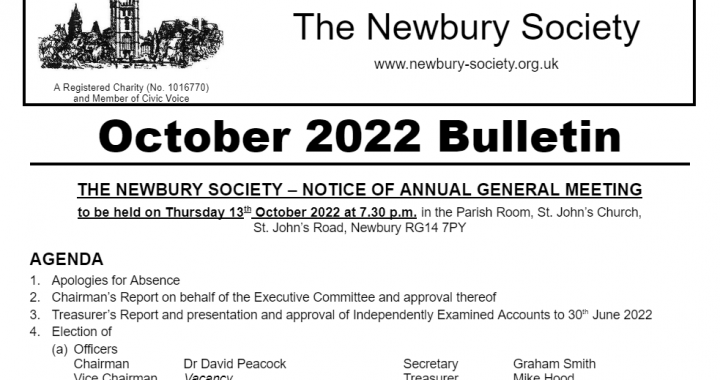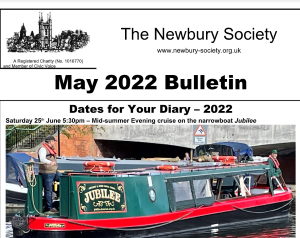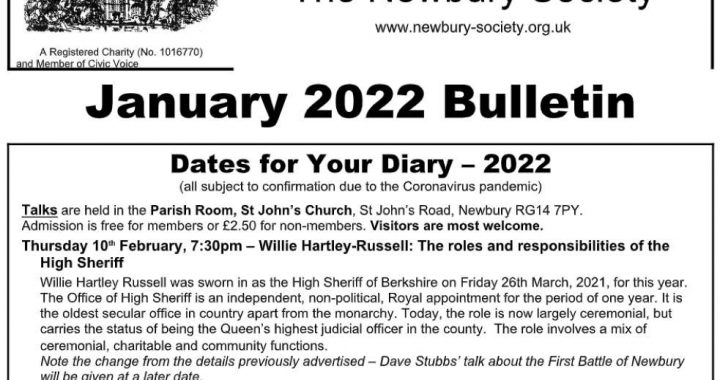THE NEWBURY SOCIETY – NOTICE OF ANNUAL GENERAL MEETING
to be held on Thursday 13th October 2022 at 7.30 p.m. in the Parish Room, St. John’s Church, St. John’s Road, Newbury RG14 7PY
AGENDA
- Apologies for Absence
- Chairman’s Report on behalf of the Executive Committee and approval thereof
- Treasurer’s Report and presentation and approval of Independently Examined Accounts to 30th June 2022
- Election of
(a) Officers
- Chairman Dr David Peacock
- Secretary Graham Smith
- Vice Chairman Vacancy
- Treasurer Mike Hood
- Committee Members
The following existing committee members are standing for re-election:
- Dr. Paul Bryant
- Garry Poulson
- John Handy
- Chris Marriage
- Appointment of Independent Examiner
- Any Other Business
- Presentation and Discussion led by David Peacock – Newbury in 2022. This will include a review of the latest version of the proposal to redevelop the Kennet Centre.
Graham V Smith
Secretary
Notes:
The Committee may appoint a Patron, a President and one or more Vice Presidents and details of these are advised to members at the AGM. Currently Lord Benyon is President and Garry Poulson is a Vice President.
All Officers and Members of the Committee retire annually but are eligible for re-election. Yolande Fothergill is not standing for re-election at this AGM.
Details are as at 3rd October 2022. Nominations are invited for additional committee members – they should be made in writing to the Secretary and have the consent of the person nominated. In the absence of sufficient nominations proposals may be accepted from the floor at the meeting.
Copies of the Annual Report and the Accounts will be available for viewing at the meeting or may be obtained in advance by contacting the Secretary
| THE NEWBURY SOCIETY – OFFICERS AND COMMITTEE 2021/22 President: Lord Benyon Vice President: Garry Poulson |
| OFFICERS Chairman, Planning Spokesman and Local History Advisor: David Peacock 01635 524017 chairman@grahamvsmith Treasurer and Membership Administrator: Mike Hood 07775 800183 treasurer@newbury-society.org.uk & membership@newbury-society.org.uk Secretary, Bulletin Editor and Waterways Representative: Graham Smith 01635 580356 secretary@newbury-society.org.uk | COMMITTEE Dr Paul Bryant Yolande Fothergill John Handy (Trees & Landscaping Advisor) Chris Marriage Garry Poulson |
New plans for the Kennet Centre
Cheap Street elevation showing the redesigned street frontage and the 10-storey blocks behind (south section – cinema to Save the Children)
Cheap Street (north section, from Save the Children) and Market Place elevation (Mays Lane is opposite Bear Lane)
The same bulk and scale as before and redesigned street frontages are the two main features of the amended plans for the development of the Kennet Centre, lodged in September.
At the heart of the development are two blocks of flats rising to ten storeys, with the top floor now in the roof. The total number of flats has come down for the original 402, to 381 last year, and 367 now; and over half have two or three bedrooms. There is still no affordable or social housing.
The most visible change between these plans and the previous versions is the redesign of street frontages in Cheap Street and Bartholomew Street. Some thought has gone into the design, and many people would agree that (at the third attempt) these present a more attractive proposal than the previous versions.
The high-rise blocks are towards the Market Street end of the development, but will be particularly visible from the Bear Lane area, behind the Catherine Wheel and “Save the Children,” both listed buildings.
The scheme, from Lochailort, is 100% Build-to-Rent. The plans include (unchanged) six-storey blocks of flats on Market Street and Bartholomew Street, and the office building proposed for Market Street is nearly the same height as the telephone exchange.
The Newbury Society is not opposed to flats as part of a redevelopment on this site, but considers that an attractive and viable development could be built with somewhere between a half and two-thirds of the flats originally proposed: in round numbers, between 200 and 270 flats.
As before, there is a stark shortage of parking included, with (according to the developers) 160 new spaces. However, only 83 spaces are specifically allocated for the use of the flats, well below the normal planning requirement.
We would urge everyone to have a look at the plans themselves, on the planning section of the West Berkshire Council website, and send in their comments. The website can be searched by putting in “kennet centre”, and the application numbers are 21/00379/FULMAJ and 21/00380/FULMAJ. The former is the main application; the latter is for 91-retirement flats, as an alternative to the office building, and would bring the total number of flats up to 458. The new plans are all listed with September 2022 dates.
Bartholomew Street frontage showing The Newbury and six-storey flats
The 10-storey Block A at the heart of the Kennet Centre development
Office building facing Market St
Boat trip 2022
The mayor of Newbury and the chairman of West Berkshire Council were welcomed as guests when the Newbury Society arranged a trip along the Kennet & Avon Canal in July.
Gary Norman and his wife Sabrina Chetcuti, with Rick Jones and his wife Valerie, joined members of the Society for a trip from Newbury Wharf out west along the canal to Benham. The trip boat “Jubilee” was hired for the occasion, and manned by volunteers from the Kennet & Avon Canal Trust.
The Society’s chair David Peacock talked about some of the history and architecture along the canal through Newbury Bridge and past West Mills, up to the line of the Lambourn Valley Railway. Then the party were able to enjoy food supplied by the Empire Cafe and on-board refreshments as they continued west with pleasant weather, through Guyers, Higgs and Benham Locks, before turning round and returning at a leisurely pace to Newbury.
The organiser for the trip was Society secretary Graham Smith, with committee members John Handy, Chris Marriage and Mike Hood also among those travelling.
Dates for Your Diary – 2022-23
Talks are held in the Parish Room, St John’s Church, St John’s Road, Newbury RG14 7PY.
Admission is free for members or £2.50 for non-members. Visitors are most welcome.
Thursday 13th October, 7:30pm – AGM (see formal notice p.1) + David Peacock: Newbury in 2022
Newbury Society chairman David Peacock will be reviewing the past year; talking about Newbury today, some of its attractions, and the range of challenges it faces.
Thursday 10th November, 7:30pm – Phil Wood: Newbury Breweries
A History of Newbury’s Breweries, from the earliest records to the final demise of the industry in the town. A lavishly illustrated talk piecing together the fascinating and often complicated history of the descent of these businesses large and small. For many years Phil, an enthusiastic local historian, has been uncovering all there is to know about the large number of pubs and breweries that once seemed to fill the town. Study of the existing pubs also gives him the opportunity for some enjoyable field work!
Thursdays 9th February, 9th March, 13th April & 11th May 2023 (all at 7:30pm) – details to be confirmed
Blue plaque to Rev. James Bicheno,
anti-slavery campaigner
The latest blue plaque was unveiled in July, to the Rev. James Bicheno, a local campaigner against the slave trade in the late 18th century. He actively promoted two petitions from Newbury to Parliament and was the Baptist minister of Newbury for 27 years.
About 1770 Bicheno fell victim to deception and was taken to America where he was sold as an indented servant. One account states that after time spent living with his master’s slaves in Virginia, Bicheno was accepted into his master’s household as his children’s tutor. In due course he was redeemed by his friends and returned to England. Once back home he trained as a Baptist minister, and was appointed Baptist minister at Falmouth before becoming the Baptist minister at Newbury in 1780.
The Society for the Abolition of the Slave Trade organised its first national campaign of petitions to the House of Commons for the abolition of the trade in 1788. Rev. James Bicheno is understood to be the author of an advertisement in the Reading Mercury (then the local newspaper) in March 1788, which appealed to “the inhabitants of Newbury” and described the conditions of slave trade, where “…multitudes perish on their passage; those who survive are sold as cattle, to be slaves for life…”
The advertisement resulted in a public meeting held on April 7, 1788 at the Mansion House in the centre of Newbury. The Mayor of Newbury, aldermen, burgesses and inhabitants of Newbury voiced their concerns about the slave trade and called for it to be stopped by any practical means. They petitioned the House of Commons to take action to end “…the horrors of a commerce which is disgraceful to our national character, and by which we become the instruments of misery to innumerable multitudes of our fellow creatures.” The petition was presented to Parliament, along with over 100 other petitions from all parts of England, but the House of Commons decided not to respond.
In 1792 Bicheno was one of ten people who called for a public meeting to consider a second petition. The meeting was held at the Mansion House on March 5, and agreed to present a petition to the Commons against “…the very great Enormity of this abominable Traffic in Human Flesh…” The petition described this as a trade “…which violates the most sacred Laws of Justice and Humanity, disgraces us as a People glorying in the exercise of Liberty and which dishonours us as Christians professing a religion that breathes Peace and Good Will to all Men.”
This petition was signed by 333 Newbury people, and was handed over to Berkshire MP Winchcombe Henry Hartley. This time the Newbury petition was one of over 500 petitions in a larger national campaign co-ordinated by the Society for the Abolition of the Slave Trade. The continuing campaign had a major success with the Slave Trade Act 1807, but it was not until the Slavery Abolition Act 1833 that slavery was abolished throughout the British Empire.
In addition to being the Baptist minister, Bicheno ran a boys’ boarding school at Greenham House, then in Greenham, which is where the plaque has been installed, on one of the gateposts to what is now the Newbury Gardens Day Nursery.
http://newbury-society.org.uk/history-of-newbury/blue-plaques has further information on this and other blue plaques in the town.
Changes in Agriculture
The way in which agriculture has changed over the past century was the theme for a talk to the Newbury Society by Mike Robinson in September.
Mike is an agronomist who has worked with many local farms for most of his life, and, using local examples, voiced particular concerns about financial support which encouraged landowners to take productive land out of food production altogether.
Among other themes, he looked at the changes in common breeds for beef and dairy production, and in sheep. He reviewed the way in which government structure had evolved, with implications for the policies followed, highlighting the former Ministry of Agriculture Fisheries and Food (MAFF), when farming and food were directly linked.
The talk was given at the St John’s Church Room in Newbury, and was followed by questions and coffee. A minute’s silence at the opening of the meeting marked the announcement of the death of Queen Elizabeth, made earlier that evening.
West Berkshire Council and heritage
Until early this year two part-time conservation officers at West Berkshire Council were responsible for all the listed buildings across West Berkshire, responding to planning applications to alter or demolish them, and also responsible for the heritage aspects of all applications in conservation areas.
One of the two officers (employees of the council, not elected councillors) retired early in the year and was not replaced. Now it appears that West Berkshire Council has decided not to replace the retired officer, leaving one part-time person with all this responsibility. This, in simple terms, is an impossible job, and the decision is a reflection of the low priority given by the Council to local heritage.
The conservation officers are crucial in protecting listed buildings and their settings, working inside the planning system. They also play a key role in providing the documents needed to protect conservation areas, Conservation Area Appraisals.
The Wharf – car parks or what?
Consultants were employed by West Berkshire Council two years ago to develop a “masterplan” for the future of Newbury town centre, which went out for consultation in the middle of last year, attracting attention mostly for a new footbridge proposed across the canal near the Waterside Centre. The plan put forward by the consultants was adopted by the council early this year, and since then more consultants have been developing aspects of it, including proposals for The Wharf.
This has now reached the stage of discussions with “stakeholders”. They propose removing the car parks in front of the library and the museum, and spending over £5m on re-vamping the area in a number of different ways. The two most expensive parts involve putting a pedestrian bridge alongside the Parkway bridge (which the consultants call the “American” bridge), to separate pedestrians and vehicles; and turning the area between the library and the canal into a public square where events can be staged. These two proposals account for £3.5m of the suggested total.
Other aspects of the scheme involve extending the “Peace Garden” back from the canal towards the museum (with more trees); work on the waterside itself (which includes structural work and possibly some facilities for boaters); and changes to the area immediately in front of the museum, keeping the taxi rank close to its present position. Also included are suggestions to improve the access to the canal from Northbrook Street, near Costa and the Old Rectory. Once a scheme is finalised, the details would be used to support funding applications.
The “masterplan” was produced by Hemingway Design, NEW Masterplanning, Urban Movement and G.L. Hearn. The proposals for The Wharf are being developed by Adams & Sutherland of Kentish Town, London.










